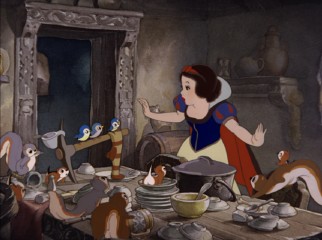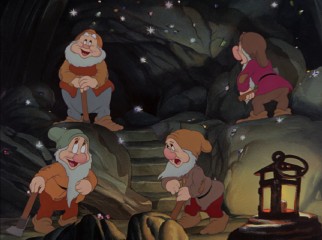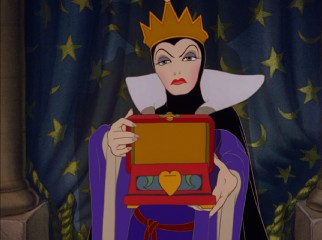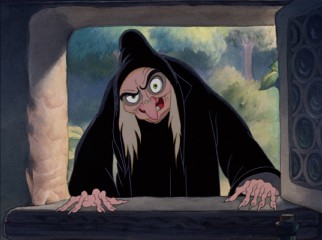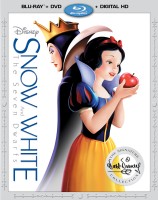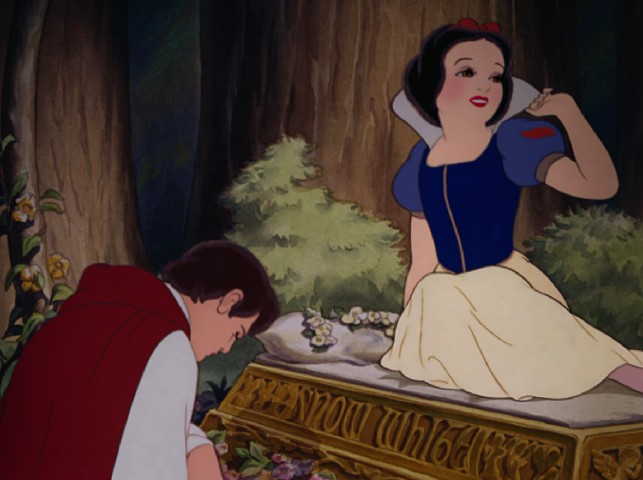Snow White and the Seven Dwarfs:
The Walt Disney Signature Collection Blu-ray + DVD + Digital HD Review
 |
Snow White and the Seven Dwarfs
Theatrical Release: December 21, 1937 / Running Time: 83 Minutes / Rating: G Director: David Hand / Writers: Ted Sears, Richard Creedon, Otto Englander, Dick Rickard, Earl Hurd, Merrill De Maris, Dorothy Ann Blank, Webb Smith (story adaptation); Wilhelm & Jacob Grimm (fairy tales) Voice Cast (uncredited): Adriana Caselotti (Snow White), Lucille LaVerne (The Queen/Old Peddler Woman), Pinto Colvig (Sleepy, Grumpy), Billy Gilbert (Sneezy), Otis Harlan (Happy), Scotty Mattraw (Bashful), Roy Atwell (Doc), Eddie Collins (Dopey), Harry Stockwell (The Prince), Stuart Buchanan (The Huntsman), Moroni Olsen (The Magic Mirror) Songs: "I'm Wishing/One Song," "With a Smile and a Song," "Whistle While You Work," "Heigh-Ho", "Bluddle-Uddle-Um-Dum (The Washing Song)", "The Silly Song," "Someday My Prince Will Come" |
Buy Snow White and the Seven Dwarfs from Amazon.com:
Walt Disney Signature Collection Blu-ray + DVD + Digital HD • Instant Video with Bonus Features • Instant Video
Past Editions: 2001 Platinum Edition DVD • 2009 Diamond Edition Blu-ray + DVD • 2009 Collector's Edition Blu-ray + DVD + Book
Anyone who knows animation can tell you that Snow White and the Seven Dwarfs is the one that started it all. The first animated feature ever produced, the 1937 blockbuster proved completely wrong the naysayers who had dubbed the film Disney's Folly during production. Not only did this film establish a market for feature-length animation, it also established the mold for Walt and his talented animators to meet that demand with vibrant, artistic color compositions, Snow White's significance cannot be overstated, but its status as a trailblazing pioneer has boosted it some in terms of its critical standing (e.g. ranking #1 on the American Film Institute's 2008 countdown of the Top 10 Animated US Films ever). Though more endearing and enduring than the vast majority of 1930s cinema, the film does not offer the gripping and exciting narrative of Pinocchio and Bambi, the innovation and artistry of Fantasia, or the sheer charm and fun of Dumbo. Those first five films of Walt are all held in extremely high regard, so no one should be ruffled by those comparisons. Your personal view of Snow White may well be shaped by your first exposure to it. Did you grow up wearing out one of its clamshell VHS tapes? Or was it something you caught later in life that can never compare to those movies you frequently treasured in childhood?
Though seemingly everyone knows the Brothers Grimm fairy tale on which this is based, I will briefly detail it. Snow White's stepmother, a vain, wicked queen, is not pleased by her Magic Mirror's report that someone else will eclipse her as fairest of them all: her own stepdaughter, whose blossoming beauty she tried to hide in rags, working her as a scullery maid. The Queen hires a huntsman to kill Snow White (being fairest of them all is no minor feat, apparently). The huntsman cannot carry out the act, so Snow White flees into the forest and with the help of friendly woodland creatures discovers a house she believes belongs to seven untidy children.
Of course, you know that Doc, Bashful, Grumpy, Happy Sleepy, Sneezy, and Dopey are not children but old diamond miners. They're startled by their uninvited houseguest and woman-hating Grumpy is especially suspicious of her feminine wiles. But she wins them over with cooking and cleaning. It might be the perfect arrangement, if not for the Queen learning of Snow White's continued existence and her plan to use a poisoned apple to place Snow White in a Sleeping Death.
Oh yes, and there's a prince, of course. He doesn't have a name or much of a personality, but Snow White meets him briefly and falls in love with him. If only there was a way for him to break that spell...
The more familiar with Disney animation from this era you are, the better you will be able to see as a confident groundbreaking debut and as the successor of increasingly sophisticated Silly Symphony shorts. The titular heroine does not have the accessible features of the many Disney princesses yet to come. She's shrill and overdramatic. Her operatic delivery, Snow White runs 83 minutes, which was a pretty common length for 1937, but is longer than many of the Disney animated features to come, with the exception of the endurance-challenging two-hour Fantasia. To reach that runtime, the film requires some padding, like forest animal gags and an extended sequence of the dwarves washing up for supper. Seriously, that must be the longest sequence in the movie. The old-fashioned charm is enough to forgive virtually anything in the film that gives you pause. Well, almost anything. I suspect the depictions could make a gender studies major squirm. But it's a different time and clearly the movie is poking fun at Grumpy's misogyny, even if it can't think of anything better for Snow White to do than cook soup and clean house while laying low.
There isn't as much to chew upon in Snow White as better Disney films, but the fact remains that without Snow White, there could be no other animated features. Surely, someone would have thought to expand into animated features; Paramount released the Fleischer Studios' Gulliver's Travels in 1939. But Snow White made Disney first and gave them control of a domain that they spent decades dominating without any real rival. Snow White may not directly influence what Pixar, DreamWorks, Illumination, Blue Sky, and even Disney themselves are doing these days, but it's always there in people's minds and something to consider when new princess movies, like Frozen and Tangled, try to put their own stamp on the genre which honoring the tradition.
Snow White's #1 status is reinforced every time Disney introduces a new home video line. In 2001, the film launched the Platinum Edition, establishing a widely appreciated tradition of bringing the studio's crown jewels to DVD in deluxe two-disc fashion every year. Later, the line expanded and moved to biannual releases, which is what the Platinum successor, Diamond Editions, maintained as it revisited those same crown jewels, this time with an emphasis on Blu-rays, though a basic DVD also featured in combo packs. With all of the studio's best-selling animated classics having made it to Blu-ray in Diamond Editions (most recently, Aladdin, last fall), Disney introduces a new series next month called The Walt Disney Signature Collection. This time around, the emphasis is on what Disney and other studios are seeing as Blu-ray's successor: Digital HD. That portable non-tangible format, provided through the company's Disney Movies Anywhere program, is in the mix along with one Blu-ray and one DVD in this premiere combo pack. VIDEO and AUDIO
Disney's animated features are regularly subjected to more dramatic restorations than most of their live-action contemporaries. They're also subjected to greater scrutiny, partly because the fans are so passionate and partly because what are we to think when colors suddenly look dramatically different than what we're used to? Presented in its original 1.37:1 Academy Ratio, Snow White looks amazing and all the more so because it turns 80 next year. A few shots are clearly not as sharp as the others, but they garner notice largely because everything else is so perfect. The colors are vibrant, the element is somehow immaculate, and the picture is even suitably filmic despite all the digital work performed on it.
There are two English soundtrack options, intended for two clear audiences. The default is a 7.1 DTS-HD master audio, a remix that makes the most of home theater sound capabilities. You'll notice a bit of channel separation in a few moments, but nothing revolutionary that would make you shudder or gasp. Throughout, the music and dialogue (shrill though it may be) is easily understood and nicely distributed. If shuddering and gasping are two things that remixes make you do, It is worth noting that DisneyView, a feature so highly touted at the launch of the Diamond line, is still provided as an option. It uses then newly-produced sidebar artwork to fill the 16:9 frame in a way that complements the visuals. Curtains, trees, pillars, and general overcast appear and change to match the scenery within. No matter how well-intentioned the feature may be, there is no great reason to watch the movie that way. Furthermore, with it activated, the Blu-ray apparently loses pop-up menu and unfinished playback resuming abilities. Sadly, the artist who made these transparent watercolor sidebars, Toby Bluth (the younger brother of accomplished animation director and Disney defector Don Bluth), passed away in 2013. A short biography and a brief message from him appear in the DisneyView section, which shows up when you select to play the film.
Continue >>
Buy Snow White and the Seven Dwarfs from Amazon.com:
|
Related Reviews:
DVDizzy.com | DVD and Blu-ray Reviews | New and Upcoming DVD & Blu-ray Schedule | Upcoming Cover Art | Search This Site
DVDizzy.com Top Stories:
Past Releases of Snow White and the Seven Dwarfs: 2009 Diamond Edition Blu-ray • 2001 Platinum Edition DVD
Disney Animated Classics on Blu-ray: Fantasia • Bambi • Dumbo
Disney Princesses on Blu-ray: Tangled • Frozen • The Princess and the Frog • Pocahontas
Text copyright 2016 DVDizzy.com. Images copyright 1937 RKO Radio Pictures, Walt Disney Pictures, and 2016 Walt Disney Studios Home Entertainment.
Unauthorized reproduction prohibited.
